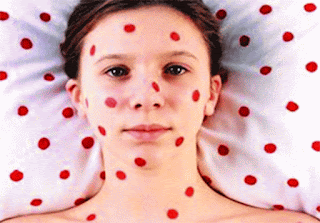Thursday, 6 July 2017
Chicken pox and rubella
Most of the "rash" diseases can be confused with the kinds of childhood diseases that are fried deeply, those with rashes (measles, rubella, girls, etc.). Sometimes, one of these diseases, such as colds, pharyngitis and so on. Allergic pimples and the like, which may be caused by medication given to the child during a disease such as.However, chicken pox can not be confused with any other disease. Common features of inflammatory diseases other than chicken pox are red stains. Some of these stains are small, some are small, some are small, others are more. In some illnesses, their association with each other is early, and some are late. The rancidity of the watercourse is unique to itself, and bubbles form in the water during the rash.
After a silent incubation period of up to fifteen days, on the face, arms, legs and stomach, mouth and nose mucosa, the female reproductive organs of the child are as little or as small as the rice spermatozoa, and these spermatozoa filled with liquid are initially transparent and itchy, Surrounded by circles. The fire falls slowly. Not all of the vagina will come out at the same time; Some of them are still filled with liquid and are transparent, the ones that come first turn into acne and then a dark shell. When examining a child who has been exposed to varicella, the skin appears to rash in separate steps. In addition to fluid-filled vesicles, there are also acnes and shells; That is, the old formations and the new ones are in a relationship. This is very important because it separates chicken pox from real flower. The chicken pox virus and the flower virus are similar; Diseases are the same appearance in terms of the wound they bring to the nature. But there is no silvil in the flower when there are liquid filled sachets inside; There are no shells while there are civilians. There is no trail that makes the face left by other flower diseases out of the dundee; Whereas the cuts of the virginity do not leave anything other than a hardly noticeable whitish blob, even in the eyebrows. When the bark spontaneously falls, it remains a small part of the colorless; Which will disappear in a few days.
In any case, the difference between the diagnosis of a flower and a virulence does not really matter today. Because flowers are a disease that is almost lifted in civilized countries. This result is regularly provided to the children by making flower buds. Like measles, this disease has no specific treatment. So there's no antibiotic to destroy the chicken pox virus. For this reason only prophylactic antibiotics are used and new diseases can be avoided in the lungs and in the lungs after the disease. The microbes with menthol on the sputum are sprayed with killer and itching reducing masks. In very young children, it is recommended to give general pain relief to infants or to bind the baby's hands and prevent itching. Scratching is dangerous not only because it will leave ugly traces, but also because the itchy places will be an open cap suitable for taking other kinds of micros.
As in the case of a rubella, a child can be sent to the school in 15-20 days after the illness has started. However, there is a more precise measure of water-flowering that determines when the infectious cycle is over, which is the disappearance of all acne traces in the water. At this point a problem arises. Sometimes, in the 20-day period, four or five shells will remain for a longer period of time if most of the first firearm vesicles disappear. It is often argued whether or not the child will be sent to the school because of these few crusts. If 20 days have elapsed in this case, if the child is washed in starchy hot water, the remaining shells will quickly settle. Thus the child can return to the school among his friends.
Measles and varicella are the most common of the rash diseases. Other effects are also seen below, but there are less common childhood diseases. Rubella comes first. The source of a virus, rubella, is common in the face, trunk, arms and legs; It disappears in 2-3 days, along with resembling the measles. It is a disease that usually occurs without fever, and there is no predictive symptom. Often it is seen that the two lymph nodes behind the ends of the jawbone end of the chin are swollen. Rubella is a harmless disease. It passes quickly; It does not lead to another disease. The child can not get out of town for a week; It can be sent to your friends at the end of this time. Nevertheless, rubella can lead to very severe conditions under certain conditions.
For example during pregnancy, especially during the first three months and at the most the second month, if the mother releases rubella there is a great danger for the child to be born. The virus, which passes through the placenta, traps some cell groups. Which group will affect depends on what period of the mother's pregnancy the mother was infected with. At the end of the first month, the baby of the mother who has rubella can have heart disease and blindness.
Subscribe to:
Post Comments (Atom)

No comments:
Post a Comment